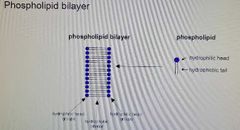![]()
![]()
![]()
Use LEFT and RIGHT arrow keys to navigate between flashcards;
Use UP and DOWN arrow keys to flip the card;
H to show hint;
A reads text to speech;
28 Cards in this Set
- Front
- Back
|
Nucleoid |
Region within a Prokaryote that houses the DNA. |
|
|
Flagella |
Hair like structure attached to bacteria that helps with movement. |
|
|
Cytoplasm |
Fluid that DNA is floating in. |
|
|
Ribosomes |
Units within the cytoplasm that produce proteins. |
|
|
Plasma Membrane |
Encloses the Nucleoid of a Prokaryote, houses the entire cell of a Eukaryote. |
|
|
Organelle |
Membrane bound compartments / structures found in Eukaryotes. I.e.: Nucleus |
|
|
Nucleus |
Membrane bound compartment that houses the DNA. |
|
|
Nuclear Envelope |
Membrane that encloses the DNA. |
|
|
Endoplasmatic Reticulum (ER) |
Rough ER: Posses Ribosomes which create proteins. Smooth ER: Creates more membrane and produces lipids. |
|
|
Golgi Apparatus |
Modifies things and decides where they need to go. |
|
|
Vesicles / Vacuoles |
Membrane bound packages like nutrients, water, pigments. |
|
|
Lysosomes |
Vesicle found in animals that contains digestive enzymes that help break things down. |
|
|
Chloroplasts |
Plant organelle that absorbs energy from the sun and converts it to chemical energy. |
|
|
Thykaloid |
Membrane containing chloroplasts. |
|
|
Stroma |
Honey like fluid that surrounds the thykaloids. |
|
|
Mitochondria |
Harvests chemical energy stored in food and turns it into usable energy through cellular respiration. |
|
|
Cristae |
Inner membrane folds of the Mitochondria. |
|
|
Matrix |
Fluid filled space inside Cristae. |
|
|
Cilia and Flagella |
Structures with hairs that flap around to move the cell. |
|
|
Phospholipid bilayer |

|
|
|
Fluid Mosaic of Molecules |
Molecules embedded in phospholipid that act as Cell Identifiers, Enzyme Catalysts, Receptors, Cell Junctions, and Molecular Transport. |
|
|
Passive Transport |
Molecules moving from A to B without energy facilitating the move. |
|
|
Simple Diffusion |
Molecules move across a membrane without help of other molecules until equilibrium is reached. |
|
|
Facilitated Diffusion |
Molecules move across a membrane with the help of a transport protein. |
|
|
Osmosis |
Movement of water molecules across a membrane. |
|
|
Active Transport |
Molecules move from an area of lower concentration to an area of higher concentration. |
|
|
Endocytosis |
Movement of large molecules into a cell. |
|
|
Exocytosis |
Movement of large molecules out of a cell. |

